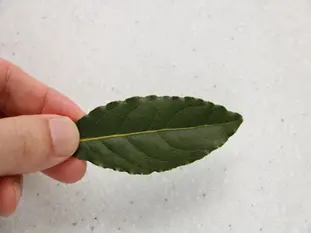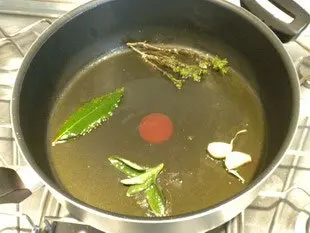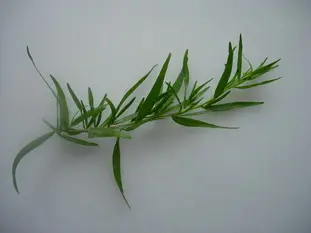This site uses only a few technical cookies necessary for its operation. By continuing to browse, you accept their use.
To find out more...
To find out more...
Herbs and temperature

I have already talked to you about herbs in cooking, and about their great power of "seduction". The example of a salad is a great classic: on its own, it's a salad, which is normal, but the same salad in which you have added finely chopped fresh herbs, just before serving, you have much more than a salad.
Herbs transcend recipes, small addition and big effect, with just a little chives, chervil, parsley, etc.
Herbs transcend recipes, small addition and big effect, with just a little chives, chervil, parsley, etc.
11 K 4.8/5 (16 reviews)
Keywords for this post:HerbsCookingTemperatureLast modified on: April 25th 2020
Herbs and temperature
What if we heat it up? What about the herbs that we are going to consume after cooking (vs raw), it's a bit the same principle, we add them to a dish or a recipe, and they always make their little effect?
Well it depends in fact, it depends on the herb itself or more exactly its active principle, its essential oil if you prefer, and which must pass from the herb in the dish for our greatest happiness.
And there attention, all the herbs are not equal, because the active ingredient they contain supports more or less well the heat.
Here is a specific example, tarragon, its active ingredient is estragol and unfortunately estragol evaporates at 50°C (approximately) which means that if you put it in a dish that goes in the oven for a long time, well it's almost useless because the taste will have evaporated during cooking and in the best case there will just be traces of it. Disappointing...
It is a little less true for parsley which is less sensitive to heat, and can be cooked better.
Another way to do it is to combine the 2 methods: herbs at the beginning for more nuanced notes, and herbs at the end for fresher and more pronounced notes.
To sum up: For a recipe with herbs, and depending on the herbs, it is often better to incorporate the herbs at the end of cooking, chopped up at the minute.

Well it depends in fact, it depends on the herb itself or more exactly its active principle, its essential oil if you prefer, and which must pass from the herb in the dish for our greatest happiness.
And there attention, all the herbs are not equal, because the active ingredient they contain supports more or less well the heat.

Here is a specific example, tarragon, its active ingredient is estragol and unfortunately estragol evaporates at 50°C (approximately) which means that if you put it in a dish that goes in the oven for a long time, well it's almost useless because the taste will have evaporated during cooking and in the best case there will just be traces of it. Disappointing...
What to do?
All is not lost, it is enough to proceed differently, and to add the chosen herb at the last moment, the dish already taken out of the oven, and a few minutes before serving. This way you will have the expected taste, and in addition a certain freshness of taste due to the fresh herbs added. This is especially true for herbs that are very sensitive to heat: chives, tarragon and chervil in particular.It is a little less true for parsley which is less sensitive to heat, and can be cooked better.
Another way to do it is to combine the 2 methods: herbs at the beginning for more nuanced notes, and herbs at the end for fresher and more pronounced notes.
Does this apply to all herbs?
No, there are some that have an active principle with a very high evaporation temperature (like 250°C), but with those you can go ahead and let it simmer or infuse for a long time: bay leaf, thyme and vanilla for example.To sum up: For a recipe with herbs, and depending on the herbs, it is often better to incorporate the herbs at the end of cooking, chopped up at the minute.
Lasts posts
Butter vs. grease
We often read in a recipe where a pastry is put into a mould that, just before pouring, the mould should be buttered or greased. But what's the difference between these 2 terms?December 1st 20259975
Getting out of the fridge early
Very often when you're cooking, you need to take food or preparations out of the fridge, to use them in the recipe in progress. There's nothing tricky about this: you just take them out of the fridge and use them, usually immediately, in the recipe. But is this really a good method?November 24th 20251,1275
Who's making the croissants?
When you look at a bakery from the outside, you naturally think that in the bakery, the bakers make the bread, and in the laboratory, the pastry chefs make the cakes. It's very often like that, with each of these professions having quite different ways of working, but sometimes there's also one...November 23th 20251,020
Oven height
When we put a dish or cake in the oven, we naturally tend to put it on the middle shelf, and that's what we usually do. But in some cases, this position and height can be a little tricky, so let's find out why.October 8th 20252,7665
The importance of sieving
In recipes that use a fine powder (flour, powdered sugar, etc.), you'll often see the advice to sift before using it. To sift is to pass the powder in question through a sieve (a very fine strainer) before incorporating it into your recipe. It's often advice, but is it really useful?September 3rd 20257,5363
Other pages you may also like
Kitchen ovens
You certainly have one in your kitchen, an oven, the essential tool for all kinds of cooking, whether in the kitchen of course, but also in pastry, bakery, pizza, and many others. Here is some information on its structure and operation.May 16th 202034 K4.4
Fruits which can ruin your jelly
There are many ways of making a fruit mousse, but one of the simplest is to prepare a fruit jelly (basically a fresh fruit coulis with gelatine) and then mix this jelly before it sets completely with whipped cream. The result is perfect for filling a charlotte, for example. But do beware;...March 6th 201378 K4.0
The window-pane test in bread-making
The home bread-makers often ask themselves “Have I kneaded my dough long enough?” . A good question, as dough that is insufficiently kneaded will not rise properly or will fall flat when the top is slashed, which is very frustrating. To know when the dough is ready, one can rely on the length...June 16th 202196 K 23.9
Perpetual stock
It's something you have probably have done yourself: cooked or pre-cooked vegetables before adding them to a recipe. This is almost always done the same way: peel the chosen vegetables (carrots, for example), cut them up, boil them in salted water (using a tablespoon or so of coarse salt per litre),...November 22th 201631 K5
Double cooking of vegetables
When you cook vegetables, it's not easy to capture and preserve the flavours. It is easy to undercook, but you can make up for it, or overcook, and then it is unfortunately a bit cooked (in the sense of "ruined"). But above all, how to get the maximum of the taste of the vegetable in the pan, then...July 12th 201924 K4.1
Post a comment or question
Follow this page
If you are interested in this page, you can "follow" it, by entering your email address here. You will then receive a notification immediately each time the page is modified or a new comment is added. Please note that you will need to confirm this following.
Note: We'll never share your e-mail address with anyone else.
Alternatively: you can subscribe to the mailing list of cooling-ez.com , you will receive a e-mail for each new recipe published on the site.









